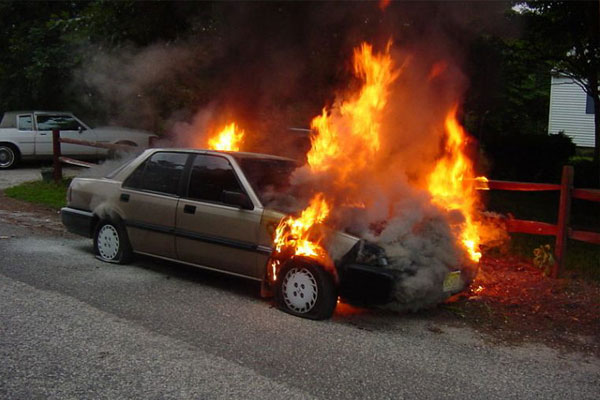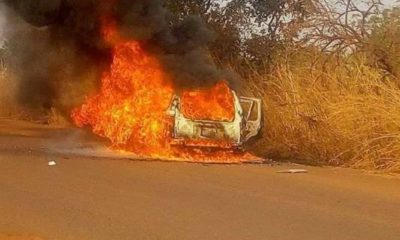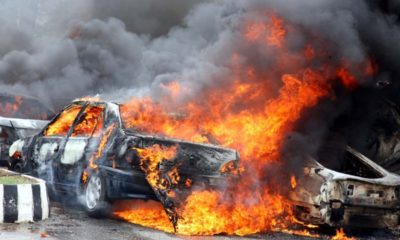A car fire has the potential to cause significant damage. Sometimes a car fire starts, but by the time it is noticed, it is usually too late.
Automobiles are notoriously prone to catching fire. They contain several electrical and hydraulic components, and even components used to construct a car might cause or be prone to fire.
Understanding the causes of a car fire, on the other hand, can help you avoid one in many cases.
Below are some causes of Car Fire.

Leaks in the Fuel System
Leaks in the fuel system are the most prevalent cause of vehicle fires, as rotted fuel lines pour petrol or diesel fuel onto hot engine parts. Petrol can easily catch fire at 45 degrees Fahrenheit (7.2 degrees Celsius) or higher when exposed to a simple spark. After all, it happens all the time in a driving car, but the engine keeps it contained. And gasoline heated to 495 degrees Fahrenheit (257.2 degrees Celsius) will spontaneously ignite.
Splashed Fluids
When the car is turned on, flammable and very dangerous fluids such as gasoline or diesel fuel circulate beneath the hood, and they can readily catch fire if their lines, hoses, or reservoirs are damaged. A fire in the bonnet, where all of these flammable liquids are concentrated, can be started by a variety of factors such as a car accident or a faulty item.
Engines that are overheating
When an engine overheats, internal fluids such as oil and coolant reach dangerously high temperatures and begin to leak out of their allocated circulation zones. When this happens, they drop, sprinkle, and spurt across the engine bay and onto the exhaust system, eventually landing on other hot parts and igniting and spreading.
An overheating engine necessitates immediate attention from a professional.
It could be a leaking seal or gasket, or the radiator could be malfunctioning. Constant overheating is a symptom that should not be over
Catalytic Converters That Have Been Overheated
An overworked(or clogged)catalytic converter can readily rise abovet 1,200 to 1,600 degrees Fahrenheit(648.9 to 871.1 degrees Celsius)to up over 2,000 degrees Fahrenheit (1,093.3 degrees Celsius). Not only does this create long-term damage to the car, but it also causes damage to the car’s surrounding parts. If the catalytic converter becomes hot enough, it can burn through the heat shields and metal floor pan, igniting the cabin insulation and carpets.
Failures of the Electrical System
The charging cycles of the battery can build up explosive hydrogen gas in the engine compartment, and the electrical current provided by the battery, along with faulty or loose wiring, can produce sparks that can quickly ignite a fluid drip or leaking petrol vapors. Electrical cabling is also found throughout the vehicle, including in channels, doors, beneath the carpet, and powered and heated seats, to mention a few places where a stray, undiscovered frayed wire could cause havoc.

Car Collisions
A car crash can even start a fire depending on the impact place. Fluid leaks and spillage, as well as heat and smoke, are likely to result after large impacts. And, as is well known, create ideal conditions for a fire. It’s best to get away from a wrecked vehicle as quickly as possible. If you’re not stuck inside a wrecked automobile, consider yourself lucky. Even if it does burst into flames, at the very least you’ll be secure.
Batteries for Hybrid and Electric Vehicles
People have long been concerned about hybrid and electric vehicle battery packs, and each new design introduces new problems.
A Tesla Model S moving at high speeds collided with a piece of debris, puncturing the battery, which then ignited like any other battery. A Chevy Volt caught fire during impact testing, which was a similar occurrence. It was discovered that in the majority of these incidents, leaky coolant combined with faulty batteries sparked the fire.
Inadequate Maintenance
A car fire can be caused by forgetting or omitting to properly maintain your vehicle. Because if you ignore defective parts, leaking seals, or bad wiring, your car will become far more favorable to the circumstances that cause a fire. A leaking gasket increases the likelihood of toxic and flammable fluids dripping from the engine. Frayed wiring has a higher chance of sparking and coming into contact with flammable items.
Design Errors
A design error, like any other cause of a car fire, is only the first step toward a fire. Although not all design defects result in a fire, any number of issues might increase the likelihood of a fire. It’s worth noting that every large and little auto maker such as BMW, VW, and Ford has recalled a vehicle due to a fire hazard.
Smoking Inside The Car
Try dropping a lit matchstick or cigarette butt on the seat without your awareness, and you’ll wind up having another cigarette out of the anxiety and dismay that your previous cigarette has left your automobile in a giant ball of fire! A practical solution is to pull over, exit the vehicle, and then smoke.
Have you ever been in a car that caught fire? Let us know what happened in the comments section below.

 News1 week ago
News1 week ago
 News1 week ago
News1 week ago
 News1 week ago
News1 week ago
 News1 week ago
News1 week ago
 News4 days ago
News4 days ago
 Latest Cars1 week ago
Latest Cars1 week ago
 News1 week ago
News1 week ago
 News1 week ago
News1 week ago





